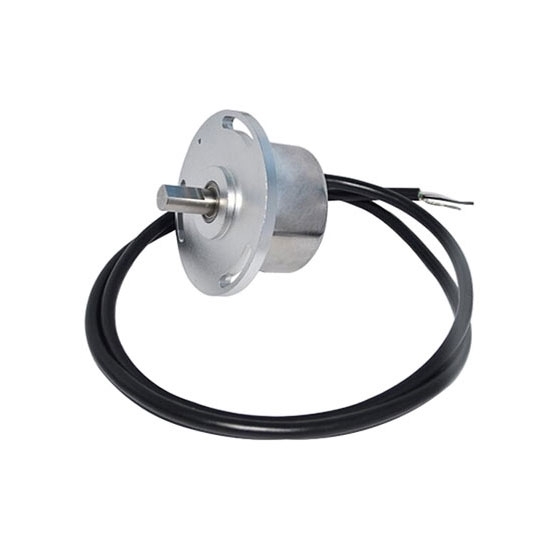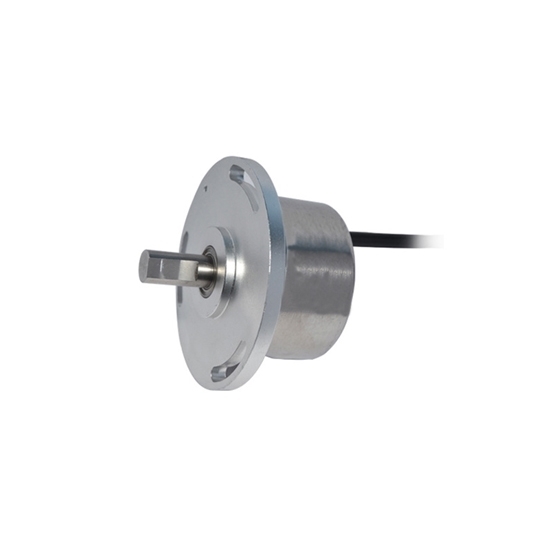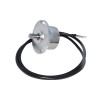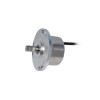



Magnetic Angle Sensor, Non-Contact, CAN BUS
from
$389.99
Ex Tax: $389.99
- Stock: In Stock
- Model: RDDLZ-AS-CAN
- Weight: 1.00
- SKU: RDDLZ-AS-CAN
Available Options
Create unlimited custom product blocks and display them in accordions or tabs or open blocks. Each block can be assigned to all products at once or specific products according to advanced criteria.
Create unlimited custom product blocks and display them in accordions or tabs or open blocks. Each block can be assigned to all products at once or specific products according to advanced criteria.
Low price angle sensor adopts magnetic signal non-contact induction and performs signal processing through a microprocessor to convert the mechanical angle into a standard signal output.
Specification
| Model | RDDLZ-LW125D | RDDLZ-HW225D |
| Full Range Precision | ±0.3° | ±0.1° |
| Temperature Drift | ±0.0015°/°C | |
| Sensitivity Temperature Coefficient | <150ppm/°C | |
| Measuring Range (Optional) | 0~30°, 0~60°, 0~90°, 0~180°, 0~270°, 0~360° | |
| Output Signal | CAN-Bus (CANH, CANL) | |
| Output Load | 240Ω | |
| Voltage Input | 9-36V DC | |
| Typical Voltage | 12V | |
| Sampling Frequency | 1KHz | |
| Linearity | 0.5%-0.15% | |
| High Vibration Resistance | >20000g | |
| Frequency Response | 100Hz | |
| Angle Resolution | 0.022° | |
| Full Range Accuracy | ±0.3° | |
| Operating Temperature | -40°C~+85°C | |
| Storage Temperature | -55°C~+100°C | |
| Power-on Startup Time | 0.2s | |
| Response Time | 0.01s | |
| Average Operation Time | ≥55000 Hour/Time | |
| Cable | with 1.5m length shielded cable 3*0.3mm2 | |
| Power Reverse Protection | 40mV | |
| Signal Reverse Protection | 40mV | |
| Running Torque | <10mN·m | |
| Material | Shell: Aluminum alloy oxidation Back Cover: Stainless steel Shaft: Stainless steel | |
| Protection Grade | IP66 | |
| Weight | 1kg | |
Dimensions (Unit: mm)
Wiring Diagram
| 1 | 2 | 3 | 4 | 5 |
| Red | White | Black | Green | Yellow |
| VCC | NC | GND | CANL | CANH |
Installation Methods
Direction of Rotation of the Spindle
Applications
Tips: How to choose an angle sensor?
- Sensitivity
Generally, within the linear range of the angle sensor, it is desirable that the higher the sensitivity of the angle sensor, the better. Because only when the sensitivity is high, the value of the output signal corresponding to the measured change is relatively large, which is conducive to signal processing. However, it should be noted that the sensitivity of the sensor is high, and external noise that has nothing to do with the measurement is also easy to mix in, and it will also be amplified by the amplification system, which affects the measurement accuracy. It should have a high signal-to-noise ratio, and try to reduce factory interference signals introduced from the outside world.
The sensitivity of the angle sensor is directional. When the measured is a single vector, and its directivity requirements are high, you should choose a sensor with less sensitivity in other directions; if the measured is a multi-dimensional vector, the cross sensitivity of the sensor is required to be as small as possible. - Frequency response characteristics
The frequency response characteristics of the angle sensor determine the frequency range to be measured, and the measurement conditions must be kept undistorted within the allowable frequency range. In fact, the response of the sensor always has a fixed delay, and it is hoped that the delay time is as short as possible.
The frequency response of the sensor is high, the signal frequency range that can be measured is wide, and due to the influence of the structural characteristics, the inertia of the mechanical system is larger, and the frequency of the measurable signal is lower due to the low frequency sensor.
In dynamic measurement, the response characteristics should be based on the characteristics of the signal (steady state, transient state, random, etc.) to avoid over-fire errors. - Linear range
The linear range of the angle sensor refers to the range in which the output is proportional to the input. In theory, the sensitivity remains constant within this range. The wider the linear range of the sensor, the larger the measuring range, and a certain measurement accuracy can be guaranteed. When selecting a sensor, when the type of sensor is determined, it is first necessary to see whether its range meets the requirements.
But in fact, no sensor can guarantee absolute linearity, and its linearity is also relative. When the required measurement accuracy is relatively low, within a certain range, the sensor with less nonlinear error can be approximately regarded as linear, which will bring great convenience to the measurement. - Stability
The ability of an angle sensor to keep its performance unchanged after a period of use is called stability. In addition to the structure of the sensor itself, the factors that affect the long-term stability of the sensor are mainly the use environment of the sensor. Therefore, in order for the sensor to have good stability, the sensor must have strong environmental adaptability.
Builder in Product TAB
NEW! Since Journal 3.2, the much improved T.A.B (Tabs Accordion Blocks) system supports the page builder inside the tab content. Unlimited Blocks, Tabs or Accordions with any HTML content or the builder interface (supporting custom rows/columns/modules) can be assigned to any individual product or to certain groups of products, like entire categories, brands, products with specific options, attributes, price range, etc.
You can indicate any criteria via the advanced product assignment mechanism and only those products matching your criteria will display the modules.
Also, any module can be selectively activated per device (desktop/tablet/phone), customer login status and other criteria. Imagine the possibilities.
